
Just when we thought serious four-wheel drive wagons were becoming a dying breed, along comes a new wave of models including the Ford Everest, Toyota Fortuner and Mitsubishi Pajero Sport.
It’s no coincidence that all these family wagons are based on utes; the Everest on the Ranger, the Fortuner on the Hilux and the Pajero Sport on the Triton.
All this comes down to economies of scale. Right around the world, Australia included, utes are big business and are being produced and sold in huge numbers. To leverage this success and gain even more commercial advantage, it makes sense to use those ute underpinnings to build a wagon, which isn’t a difficult thing, from an engineering point of view.
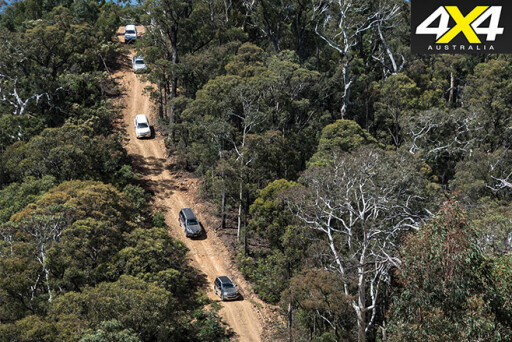 All the popular utes are built on a separate chassis so, in very simple terms, it’s just a matter of lifting the ute body off its chassis and replacing it with a wagon body. Of course things aren’t quite that simple, but at the same time, they aren’t too complicated either.
All the popular utes are built on a separate chassis so, in very simple terms, it’s just a matter of lifting the ute body off its chassis and replacing it with a wagon body. Of course things aren’t quite that simple, but at the same time, they aren’t too complicated either.
Today’s utes have very long wheelbases to accommodate roomy double-cabs and decent-sized trays, so the first step is to shorten the wheelbase. You also don’t need heavy-duty leaf springs so while you’re shortening the chassis rails you can junk the leaf springs and replace them with softer-riding coils. Finally, you can replace the rear drum brakes with discs.
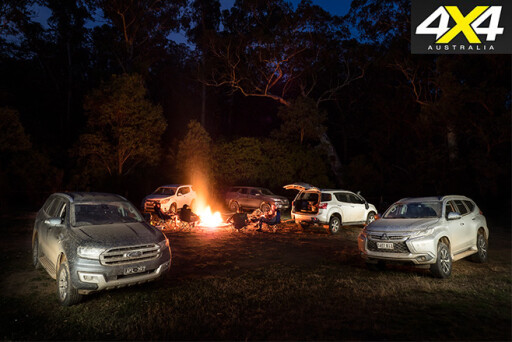 This is a relatively cheap way to produce a 4x4 wagon, and it means the resulting wagon will enjoy the benefits of the ute’s robust and relatively simple platform – just what you want in a four-wheel drive.
This is a relatively cheap way to produce a 4x4 wagon, and it means the resulting wagon will enjoy the benefits of the ute’s robust and relatively simple platform – just what you want in a four-wheel drive.
Here we have lined up the Everest, Fortuner and the Pajero Sport, with the existing Holden’s Colorado 7 and Isuzu’s MU-X, both of which are also ute-derived wagons...
FORD EVEREST
THE EVEREST WAS OUR BEST NEW 4X4 Of 2015 AND IS THE MOST SOPHISTICATED OF THE FIVE WAGONS HERE.
The Everest arrived in late 2015 and is the only wagon here designed and developed in Australia. It comes in a range of three models, all with automatic transmissions.

The Everest is powered by the same 3.2-litre, five-cylinder diesel that’s in the Ranger. It also features the same engine upgrades that arrived with the Ranger’s mid-life facelift in 2015.
These include a smaller, more efficient turbo for faster spool-up, a revised fuel-injection system, and other cylinder-head changes aimed at making the engine quieter and more refined.
Where the Everest differs from the Ranger is in the use of selective catalytic reduction (aka AdBlue) tech that reduces the production of NOx so the Everest can meet up-coming Euro 6 emission standards. As a result of this ‘greening’, the Everest’s maximum power is 143kW, 4kW less than the Ranger’s, although maximum torque remains unchanged at 470Nm.
On the road this engine has a relaxed and easy gait, thanks to the fact its bigger capacity makes good power at low engine speeds. The five-cylinder arrangement also means it’s very smooth once underway, even if it has a somewhat lumpy idle, compared to its four-cylinder rivals.
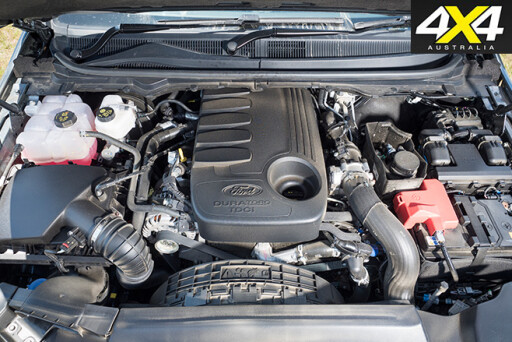 The Everest performs strongly, despite being the heaviest vehicle here. Mind you, even without the extra weight, the 3.2-litre five tends to be a bit on the thirsty side, as evidenced by the Ranger and Mazda BT-50. It’s no surprise the Everest’s extra weight compounds the problem.
The Everest performs strongly, despite being the heaviest vehicle here. Mind you, even without the extra weight, the 3.2-litre five tends to be a bit on the thirsty side, as evidenced by the Ranger and Mazda BT-50. It’s no surprise the Everest’s extra weight compounds the problem.
For its part, the six-speed auto offers well-timed, smooth and decisive shifts, and it doesn’t fidget between gears on undulating roads as much as some other wagons here.
HANDLING AND RIDE
The first thing you notice about the Everest’s on-road dynamics is the light feel of its electrically assisted steering, especially at very low speeds. The steering weight increases at higher road speeds, but always feels somewhat remote and never offers high-quality feedback. The good news is you get used to the steering, and the rest of the dynamic performance is all good.
The Everest corners more neutrally than any vehicle here and has a surprisingly flat stance, even when pushed hard.
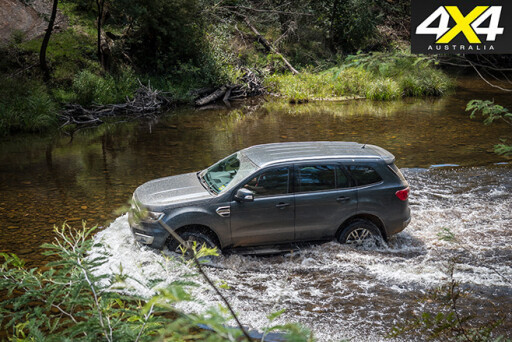 The other ace up the Everest’s sleeve is its full-time 4x4. On a dry, sealed road it’s not a significant benefit, but it really comes into its own on roads that alternate between being sealed and unsealed or wet and dry. And while the Pajero Sport has selectable full-time 4x4, it lacks the ‘smart’ centre diff of the Everest that directs the drive to the axle that can use it most.
The other ace up the Everest’s sleeve is its full-time 4x4. On a dry, sealed road it’s not a significant benefit, but it really comes into its own on roads that alternate between being sealed and unsealed or wet and dry. And while the Pajero Sport has selectable full-time 4x4, it lacks the ‘smart’ centre diff of the Everest that directs the drive to the axle that can use it most.
OFF-ROAD
The Everest’s strong showing continues off road, with one major exception: the over-bonnet visibility is the poorest here and can be a problem in more difficult going, especially when cresting steep inclines.
The other side of the story is that the Everest is one of the three vehicles here with a rear diff lock standard across the range. However, it’s the only one that keeps the traction control active on the front axle when the locker is engaged. This is a real bonus as the traction control alone isn’t as effective as it could be.
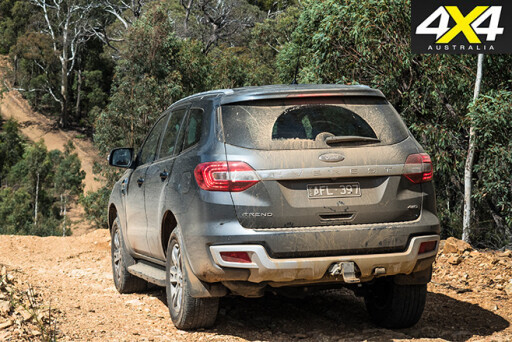 More generally, the Everest has good clearance and decent approach and departure angles, and although the air intake is under the bonnet lip, it’s still well-protected from water ingress.
More generally, the Everest has good clearance and decent approach and departure angles, and although the air intake is under the bonnet lip, it’s still well-protected from water ingress.
CABIN AND ACCOMMODATION
Even without reach adjustment for the steering wheel, the Everest offers a comfortable driving position for short and tall drivers, thanks to its excellent seats. Not so good are the small, hard-to-read symbols on the heating, ventilating and air-con (HVAC) controls, and the generally fiddly and busy nature of the dashboard.
Behind the front row is a mixed bag. The second row is among the best here, but the third row is the most difficult to get in and out of, and it’s the most cramped once you are in there. At least there’s a handy amount of luggage space behind the third row when it’s deployed.
WHAT YOU GET
All Everests have seven seats, a rear-view camera, rear parking sensors, a 230V outlet, and a rear diff lock.
The Trend adds 18s, a power tailgate, side-steps, projector headlights, daytime running lamps, dual-zone climate, auto wipers, an 8.0-inch touchscreen, adaptive cruise control, forward crash mitigation, lane-departure warning, and sat-nav as an option.
 The Titanium adds 20s, leather, electric-adjust seating, power-fold third row, HID headlights with LEDs, a sunroof, park assist, blind-spot monitoring, rear cross-traffic alert, tyre-pressure monitoring and sat-nav.
The Titanium adds 20s, leather, electric-adjust seating, power-fold third row, HID headlights with LEDs, a sunroof, park assist, blind-spot monitoring, rear cross-traffic alert, tyre-pressure monitoring and sat-nav.
SUM UP
The Everest didn’t win our 4x4 Of The Year for nothing. It’s a polished performer both on and off the road and offers a level of sophistication – in terms of its powertrain and equipment – that the others can’t match. But it’s also the most expensive vehicle here.
SPECS: FORD EVEREST TREND
Engine: 3.2-litre 5-cyl turbo-diesel
Maximum power: 143kW @ 3000rpm
Maximum torque: 470Nm @ 1750-2500rpm
Gearbox: six-speed automatic
4x4 system: dual-range full-time
Crawl ratio: 38.6:1
Tyre spec: 265/60R18 110T
Kerb weight: 2407kg
GVM: 3100kg
Payload: 693kg
Towing capacity: 3000kg
Fuel tank capacity: 80 litres
ADR fuel claim: 8.5L/100km
Test fuel use: 14.4L/100km
Touring range*: 505km
*Based on fuel tank capacity, test fuel use and a 50km ‘safety’ margin.
FORD EVEREST PRICES*
Ambiente: $54,990
Trend: $60,990
Titanium: $76,990
*Does not include on-road costs.
HOLDEN COLORADO 7
THE COLORADO 7 CARRIES A HOLDEN BADGE BUT HAS AN INTERNATIONAL CHARACTER ALL OF ITS OWN
The Colorado 7 is the oldest vehicle here, arriving in late 2012 before a significant revamp just 12 months later. The Colorado 7 and the MU-X are of course related and share the same basic chassis structure and body shell but with different powertrains, suspension tunes, interiors, exterior detailing and equipment. The Colorado 7 is sold in Southeast Asia, India, Brazil, South Africa and parts of the Middle East as the Chevrolet TrailBlazer. In Australia the Colorado 7 comes in two models (LT and LTZ), both of which have an auto gearbox. There’s no manual option.
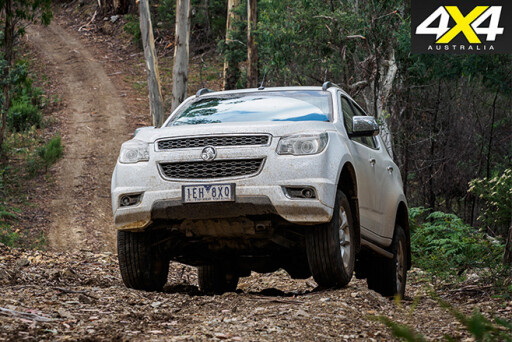 POWERTRAIN AND PERFORMANCE
POWERTRAIN AND PERFORMANCE
The Colorado 7 is powered by a 2.8-litre, four-cylinder diesel from Italian diesel specialist VM Motori. Thanks to intricacies of the global automotive industry that are too detailed to go into, this is essentially the same engine that’s in the Jeep Wrangler but with more grunt.
In the Colorado 7, it claims a substantial 147kW and 500Nm. This puts it at the head of the pack in this company when it comes to claimed power and torque. The engine is backed by a six-speed GM automatic transmission that’s also been used in the V8 Commodore.
Holden has squeezed more out of this engine than what it offered when the Colorado 7 first arrived, and in many ways it shows. In this company the engine is somewhat noisy and harsh, and it’s certainly the least refined here. It also needs more revs than all but the Pajero Sport’s engine to do its best work. This reflects in the fact that its economy is poorer than all but the much heavier Everest. The upside is the Colorado 7 is the performance leader here.
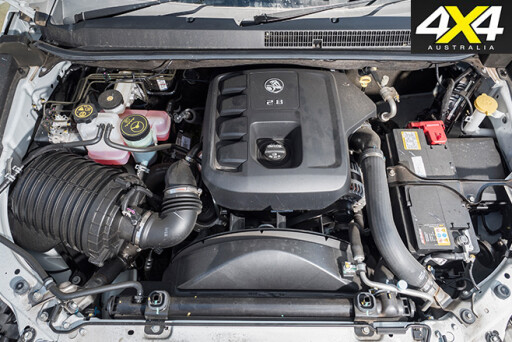 For its part, the gearbox shifts when you want it to and is well matched to the engine, but the shifts aren’t as smooth or as quick as the slicker gearboxes in the Everest, Fortuner and Pajero Sport.
For its part, the gearbox shifts when you want it to and is well matched to the engine, but the shifts aren’t as smooth or as quick as the slicker gearboxes in the Everest, Fortuner and Pajero Sport.
HANDLING AND RIDE
The Colorado 7 and the MU-X share the same basic chassis structure, but the two vehicles have gone their own way in terms of spring and damper calibration.
Holden has opted for a firmer set-up, which provides flatter handling, and on tight, winding roads the Holden is one of the better vehicles here, despite its steering not offering great feel or feedback. The downside is that the ride is hard, even harsh on some roads, and there’s also a fair deal of road noise compared to the other vehicles here.
OFF-ROAD
The Colorado 7 offers great over-bonnet vision and covers all the off-road basics, including ground clearance and approach and departure angles. The six-speed auto works a treat off road, and it’s a nice touch the way the engine revs ‘blip’ on downshifts to smooth out the engagement of the lower gear.
 On the negative side, the ride is harsh and uncomfortable, especially on rocky trails, something that can get particularly tiresome after extended time off road. The Colorado 7’s traction control isn’t the best either, and there’s no diff lock to resort to when the going gets particularly difficult.
On the negative side, the ride is harsh and uncomfortable, especially on rocky trails, something that can get particularly tiresome after extended time off road. The Colorado 7’s traction control isn’t the best either, and there’s no diff lock to resort to when the going gets particularly difficult.
That’s not to say the Colorado 7 isn’t a capable off-roader – it’s just not a frontrunner in this company.
CABIN AND ACCOMMODATION
The Colorado 7 has an airy, open feel to the cabin and a comfortable driving position, despite not having reach adjustment for the steering wheel. Not so good is the dated look of the dash and the use of cheap, hard plastics.
Like the MU-X, the second-row seat has good headroom but less legroom than the Everest and the Fortuner, and the seating position has the same ‘legs up’ feel. Again, like in the MU-X, the third row is roomy and the best here at accommodating adults, although the seats, when folded down, make for a high cargo floor.
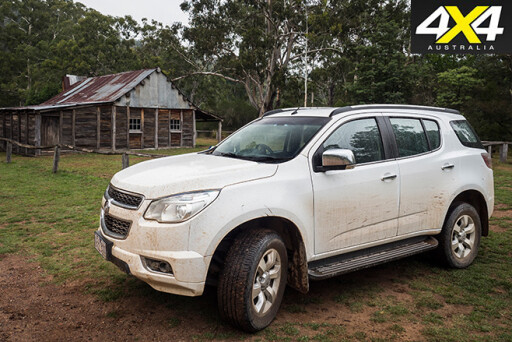 WHAT YOU GET
WHAT YOU GET
The Colorado 7, in both models, comes with seven seats, a reversing camera, rear parking sensors, and a seven-inch touchscreen, which can be used as a sat-nav via a separately purchased smart phone app. Over and above the LT, the LTZ comes with leather, electric-adjust for the driver’s seat, climate control air-con, self-levelling projector headlights and 18-inch alloys, rather than the 16s on the LT.
SUM UP
Despite slow sales at first, the Colorado 7 has grown in popularity thanks to sharp pricing and plenty of TV ads. Since its release in late 2012 it has been revamped a couple of times and is coming up for another facelift this year. If you think all that suggests Holden has never been entirely happy with the Colorado 7, you’re probably right.
SPECS: HOLDEN COLORADO 7 LTZ
Engine: 2.8-litre 4-cyl turbodiesel
Maximum power: 147kW @ 3600rpm
Maximum torque: 500Nm @ 2000rpm
Gearbox: six-speed automatic
4x4 system: dual-range part-time
Crawl ratio: 36.4:1
Tyre spec: 265/60R18 110T
Kerb weight: 2205kg
GVM: 2820kg
Payload: 615kg
Towing capacity: 3000kg
Fuel tank capacity: 76 litres
ADR fuel claim: 9.2L/100km
Test fuel use: 14.3L/100km
Touring range*: 481km
*Based on fuel tank capacity, test fuel use and a 50km ‘safety’ margin.
HOLDEN COLORADO PRICES*
LT: $47,990
LTZ: $51,490
*Does not include on-road costs.
ISUZU MU-X
WHAT THE MU-X LACKS IN TECHINCAL SOPHISTICATION IT MAKES UP FOR WITH ITS BASIC, WELL-PROVEN POWERTRAIN
Isuzu’s MU-X debuted in Australia in late 2013 after the release of Isuzu’s D-Max ute, upon which the wagon is based. Since then it has remained virtually unchanged and, of the five wagons tested here, it is one of only two offered with a manual gearbox. It’s also the only one sold with a 2WD option.
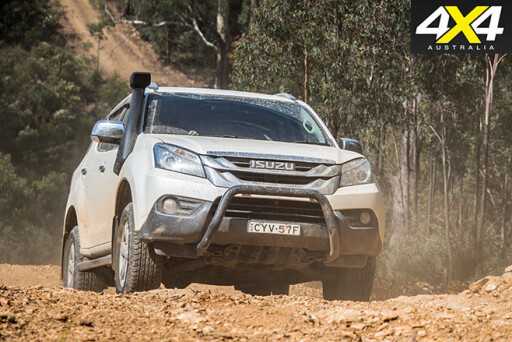 POWERTRAIN AND PERFORMANCE
POWERTRAIN AND PERFORMANCE
The MU-X’s 3.0-litre, four-cylinder diesel claims 130kW and 380Nm, which puts it at the tail-end of the field in terms of on-paper power and torque – the Toyota Fortuner also claims 130kW, but it produces more torque, 450Nm.
The MU-X’s diesel is the latest iteration of the Isuzu engine used as far back as the last Holden Rodeo (which was an Isuzu anyway), and it’s backed by the Aisin five-speed auto used widely by Toyota in various Prado and Land Cruiser models.
On the road the engine offers easy performance; it has good torque from idle and is only found wanting in pedal-to-the-metal situations such as overtaking. It’s not the quietest or most refined engine here, given most of the other engines are newer designs, but it’s not bad and is more pleasant in terms of noise vibration and harshness (NVH) than the Colorado 7’s engine. It’s also one of the more economical, as we have found many times before, even if it falls short of the Fortuner’s economy in this contest.
 For its part, the gearbox feels a little old-school in this company and is the only five-speed here (all the rest have six or more speeds). The shifts are still relatively smooth, but they are not always well-timed, and the overall shift protocols seem skewed towards economy rather than performance, which can be frustrating on more demanding roads.
For its part, the gearbox feels a little old-school in this company and is the only five-speed here (all the rest have six or more speeds). The shifts are still relatively smooth, but they are not always well-timed, and the overall shift protocols seem skewed towards economy rather than performance, which can be frustrating on more demanding roads.
HANDLING AND RIDE
None of these wagons scale any great heights in terms of on-road handling, as they are all based on commercial underpinnings and have live rear axles.
As with most the vehicles here – except the Everest – the MU-X tends to understeer when pushed hard and there’s a fair degree of body roll. The upside to this is the MU-X’s relatively soft and comfortable ride, something that sets it apart from the Colorado 7, with which it shares its basic chassis.
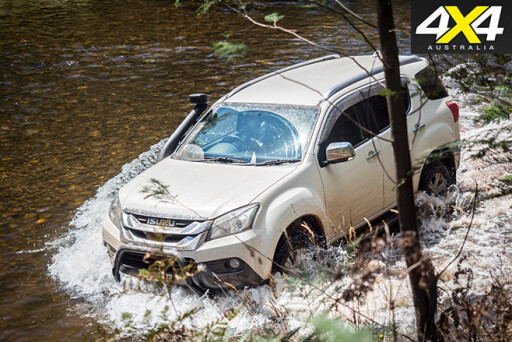 OFF-ROAD
OFF-ROAD
The MU-X is a solid and tough off-roader that has all the basics right, including decent wheel travel, good clearance and tidy approach and departure angles. It also has excellent over-bonnet visibility. But it lacks a rear locker and the traction control isn’t as effective as some of the others.
The MU-X also has the least effective engine braking and doesn’t come with hill-descent control, although that’s never a make-or-break issue when you have dual-range gearing.
The gearbox also lacks the ‘smart’ off-road shift protocols of the others and requires the driver to use manual control more in difficult going.
CABIN AND ACCOMMODATION
The MU-X’s cabin looks dated compared to the newer designs from Mitsubishi, Ford and Toyota, and it has more of a commercial feel than a passenger-vehicle feel. That said, the dash is modest and well laid-out and there’s nothing that doesn’t ‘work’ in a simple and predicable way. The driving position, too, is reasonably comfortable, even without reach adjustment for the steering wheel.
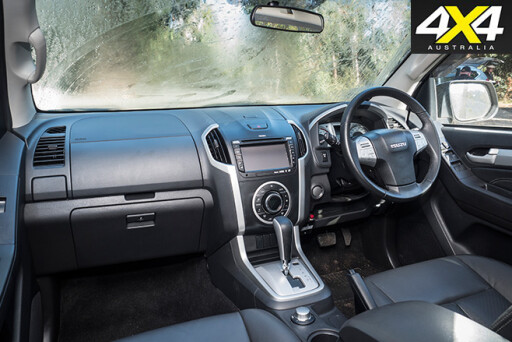 The second-row seat has good headroom but less leg room than the second rows in the Everest and the Fortuner, and the seating position feels somewhat ‘legs up’. In contrast, the third-row seat, along with the Colorado’s, is the best here, although when folded down the seats eat into the luggage space and create a high cargo floor.
The second-row seat has good headroom but less leg room than the second rows in the Everest and the Fortuner, and the seating position feels somewhat ‘legs up’. In contrast, the third-row seat, along with the Colorado’s, is the best here, although when folded down the seats eat into the luggage space and create a high cargo floor.
WHAT YOU GET
All models, except the top-spec LS-T, come with the option of a manual or automatic transmission, and all have seven seats and rear parking sensors. Above the base LS-M, the LS-U adds dual-zone climate control, air-con outlets for the rear-seat passengers, fog lights, side-steps and roof rails, while 17s replace 16s. The LS-T adds leather seats with electric-adjust for the driver, sat-nav and a reversing camera. The LS-T also has a premium audio system with eight, rather than six, speakers and a rear DVD system with a 10-inch, roof-mounted screen.
 SUM UP
SUM UP
The MU-X is one of the two older designs here and in many ways it shows. But it’s well priced and has an exceptionally well-proven engine and gearbox. It has a basic design and its electronics are relatively simple, meaning there’s less to go wrong than in the far more complex Everest or Pajero Sport. It’s also one of only two vehicles here offered with a manual gearbox
SPECS: ISUZU MU-X LS-T
Engine: 3.0-litre 4-cyl turbodiesel
Maximum power: 130kW @ 3600rpm
Maximum torque: 380Nm @1800–2800rpm
Gearbox: five-speed automatic
4x4 system: dual-range part-time
Crawl ratio: 32.6:1
Tyre spec: 255/65R17 110S
Kerb weight: 2060kg
GVM: 2750kg
Payload: 690kg
Towing capacity: 3000kg
Fuel tank capacity: 76 litres
ADR fuel claim: 8.1L/100km
Test fuel use: 12.8L/100km
Touring range*: 544km
*Based on fuel tank capacity, test fuel use and a 50km ‘safety’ margin.
ISUZU MU-X 4X4 PRICES*
LS-M (manual) $45,600
LS-M (auto) $47,800
LS-U (manual) $47,100
LS-U (auto) $49,300
LS-T (auto only) $54,000
*Does not include on-road costs.
MITSUBISHI PAJERO SPORT
DESPITE ITS NAME, THE PAJERO SPORT HAS NOTHING TO DO WITH THE PAJERO, EXCEPT THAT MITSUBISHI MAKES BOTH.
Based on the new Triton that arrived early in 2015, the Pajero Sport is a replacement for the Challenger, but with a new name. Well, the name is new for Australia, as in some overseas markets the previous generations of the Challenger have been called Pajero Sport for the better part of 20 years.
 In this company the Pajero Sport is the odd man out. It seats five rather than seven, is generally smaller than the rest and is the only one that doesn’t share the auto ’box of its donor ute, which in this case is a good thing. It also comes with selectable full-time 4x4, not part-time.
In this company the Pajero Sport is the odd man out. It seats five rather than seven, is generally smaller than the rest and is the only one that doesn’t share the auto ’box of its donor ute, which in this case is a good thing. It also comes with selectable full-time 4x4, not part-time.
POWERTRAIN AND PERFORMANCE
The Pajero Sport is powered by the same 2.4-litre turbo-diesel that debuted in the new Triton in early 2015. This engine follows the trend of recent diesel development, with a relatively low compression ratio (15.5:1) and a small but fast-responding turbo.
For a relatively small engine, it claims strong figures of 133kW and 430Nm. Max torque isn’t achieved until 2500rpm, which is a very high figure for a modern turbodiesel, given that most achieve maximum torque on the south side of 2000rpm. This engine is mated to an eight-speed Aisin automatic rather than the five-speed automatic found in the new Triton.
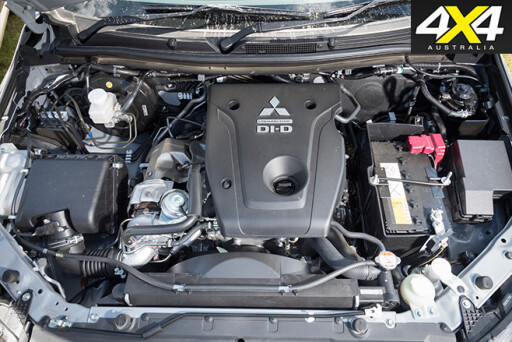 On the road this engine is relatively quiet and refined, certainly more so than the Colorado 7’s and MU-X’s. It performs better than its numbers suggest, thanks to its close ratios of its eight-speed and its relative lightness. What the auto also does is effectively mask that its engine lacks the low-rpm punch of the other engines, so it never feels wanting in comparison.
On the road this engine is relatively quiet and refined, certainly more so than the Colorado 7’s and MU-X’s. It performs better than its numbers suggest, thanks to its close ratios of its eight-speed and its relative lightness. What the auto also does is effectively mask that its engine lacks the low-rpm punch of the other engines, so it never feels wanting in comparison.
The Pajero Sport also achieved the second best fuel economy, after the Toyota, which is a good thing as it has the smallest fuel tank, at just 68 litres – 12 litres short of the best here.
HANDLING AND RIDE
The Pajero Sport feels small and nimble in this company, but it would feel a lot sportier if Mitsubishi hadn’t decided to opt for a soft suspension tune. The end result is a fair degree of body roll and understeer when pushed hard. On a positive note, the ride quality on rough roads is excellent.
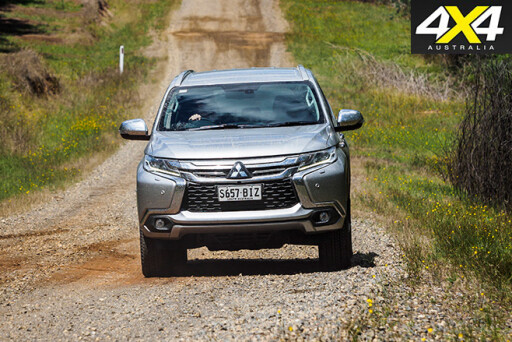 Regardless of the suspension tune, the Sport’s on-road trump card is its selectable full-time 4x4, which is just the ticket for wet bitumen, gravel and in situations where the road surface is constantly changing. It’s not an ‘active’ full-time 4x4 system like the Everest’s, as it uses a conventional mechanical diff that is fully open unless manually locked by the driver via the rotary switch that controls the Super Select system.
Regardless of the suspension tune, the Sport’s on-road trump card is its selectable full-time 4x4, which is just the ticket for wet bitumen, gravel and in situations where the road surface is constantly changing. It’s not an ‘active’ full-time 4x4 system like the Everest’s, as it uses a conventional mechanical diff that is fully open unless manually locked by the driver via the rotary switch that controls the Super Select system.
Unlike the Everest, however, the Pajero Sport has the option of 2WD, which is useful for long highway drives.
OFF-ROAD
The Pajero Sport doesn’t win too many prizes off road. It gets the job done, but over-bonnet vision, ground clearance and its departure angle aren’t great. It feels to be down on rear-wheel travel, and the traction control could be more effective.
The mid-spec GLS and top-spec Exceed do, however, have a rear locker as standard but, as with the Fortuner, engaging the rear locker cancels the traction on both axles.
 The eight-speed auto works well off road and has the lowest crawl ratio, but downshifts can be abrupt at times. At least the soft suspension tune means a very comfortable off-road ride.
The eight-speed auto works well off road and has the lowest crawl ratio, but downshifts can be abrupt at times. At least the soft suspension tune means a very comfortable off-road ride.
CABIN AND ACCOMMODATION
The Pajero Sport has a very modern and expensive feel to its cabin, but the dash is overly complicated and busy. In this company the cabin also feels smaller and more closed-in.
Tilt-and-reach steering wheel adjustment is a plus and the driving position should please short drivers, though tall drivers will be a bit cramped, especially by the large centre console.
The second-row seat is also the smallest here and, while there’s no third row, there’s plenty of luggage space.
WHAT YOU GET
All Pajero Sport models have five seats, 18-inch alloys, LED headlamps and DRLs, tilt-and-reach steering wheel adjustment, ‘smart’ entry and start, digital radio, hill-descent control, rear parking sensors and a reversing camera. Over the GLX, the GLS has a rear locker, a cargo blind, dual-zone climate, leather, electric-adjust seats for driver and passenger, six speakers (up from four), and auto headlights and wipers. The top-spec Exceed then adds headlight washers, two additional speakers, a rear DVD system, blind-spot monitoring and forward crash mitigation.
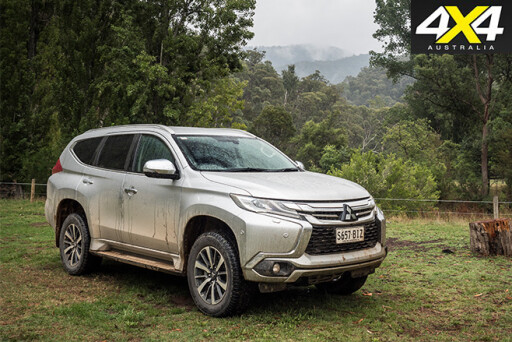 SUM UP
SUM UP
In this company the Pajero Sport is very well priced. Its official starting point is cheaper than anything here, and the top-spec model is cheaper than all but the top-spec Colorado 7. To give another perspective, the top-spec Pajero Sport is cheaper than the base-spec Everest.
SPECS: MITSUBISHI PAJERO SPORT EXCEED
Engine: 2.4 litre 4-cyl turbodiesel
Maximum power: 133kW @ 3500rpm
Maximum torque: 430Nm @ 2500rpm
Gearbox: eight-speed automatic
4x4 system: dual-range full-time (+2WD)
Crawl ratio: 45.9:1
Tyre spec: 265/60R18 110H
Kerb weight: 2070kg
GVM: 2710kg
Payload: 640kg
Towing capacity: 3100kg
Fuel tank capacity: 68 litres
ADR fuel claim: 8.0L/100km
Test fuel use: 12.7L/100km
Touring range*: 485km
*Based on fuel tank capacity, test fuel use and a 50km ‘safety’ margin.
MITSUBISHI PAJERO SPORT PRICES*
GLX: $45,000
GLS: $48,500
Exceed: $52,750
*Does not include on-road costs.
TOYOTA FORTUNER
TOYOTA'S ALL-NEW FORTUNER CARRIES ON WHERE THE 4RUNNER LEFT OFF MANY YEARS AGO.
Developed alongside the all-new Hilux, the Fortuner is in every sense a modern-day 4Runner.
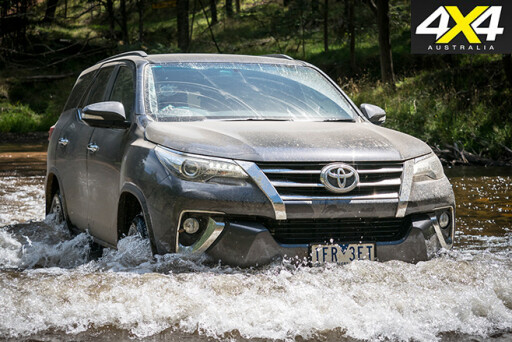 But why would Toyota bother with the Fortuner when it already has its hugely successful Prado? Well, the Fortuner is noticeably cheaper than the Prado and, at the lower end of the range, better equipped as well.
But why would Toyota bother with the Fortuner when it already has its hugely successful Prado? Well, the Fortuner is noticeably cheaper than the Prado and, at the lower end of the range, better equipped as well.
The Fortuner comes in a six-model range, the most extensive here. It’s available in three spec levels, with the option of a six-speed manual or a six-speed automatic across the range.
POWERTRAIN AND PERFORMANCE
The Fortuner is powered by Toyota’s new 2.8-litre GD-1 diesel, where GD stands for Global Diesel. It claims a modest 130kW, the equal lowest power output here, but it offers a substantial 450Nm, which is on tap from as low as 1600rpm and continues unabated until 2400rpm. No other engine here has its maximum torque arrive at such a low engine speed.
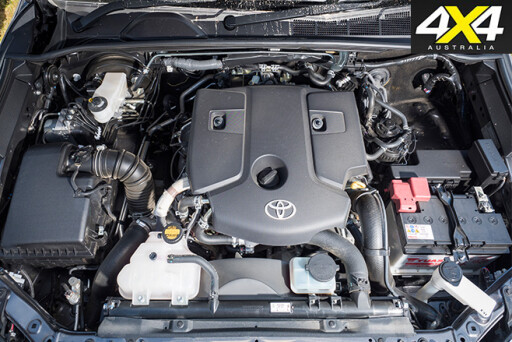 On the road the 130kW doesn’t translate to scintillating pedal-to-the-metal performance, given the Fortuner weighs more than 2100kg, but the engine is still responsive, willing and generally effortless in give-and-take driving. Also impressive is its noise abatement and general refinement, which is the best here.
On the road the 130kW doesn’t translate to scintillating pedal-to-the-metal performance, given the Fortuner weighs more than 2100kg, but the engine is still responsive, willing and generally effortless in give-and-take driving. Also impressive is its noise abatement and general refinement, which is the best here.
Nice refinement, too, from the new six-speed auto, which offers smooth shifts and generally smart shift protocols. Thanks to two overdrive ratios, it offers very tall highway gearing, but there’s also some shuffling between the fifth and sixth when on undulating roads, at legal highway speeds. This is a gearbox designed for economy, not performance.
RIDE AND HANDLING
In most ways, the Fortuner rides and handles the way you would expect of a vehicle based on a ute, although it does have a soft, compliant and well-sorted ride on rough roads, thanks no doubt to the large amount of local suspension tuning done during its development.
The Fortuner’s steering calibration was also done locally and is light at low speeds but offers decent feel and feedback at higher road speeds. Not so good is its tendency to understeer when pushed hard in tight corners, which is typical of the conservative approach Toyota takes to chassis balance in its 4x4s and SUVs.
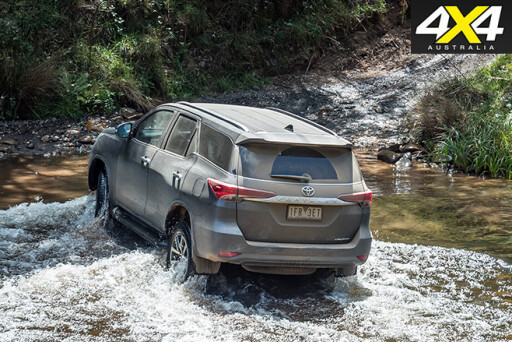 OFF-ROAD
OFF-ROAD
The Fortuner’s off-road credentials centre on its generous ground clearance, steep approach and departure angles, and excellent rear-wheel travel. There’s good vision, too, from the driver’s seat.
All models come with a driver-switched rear diff lock, but it’s not all that useful, as engaging the rear locker cancels traction control on both axles.
The good news is that the off-road tuned ‘A-TRC’ traction control is the best here. Like the Hilux, the Fortuner has solid underbody protection. The auto gearbox also works well off road.
CABIN AND ACCOMMODATION
The Fortuner’s passenger car-like dash is dominated by a tablet-style touchscreen, which has some functionality issues.
Better news comes in the form of tilt-and-reach steering wheel adjustment and driver’s-seat height adjustment on all models. This is one of the few vehicles here that suits both tall and short drivers.
 The second-row passengers are well looked after in terms of leg room, but the head room isn’t as good as in the Everest, MU-X or Colorado 7. One handy feature is that the second-row seat adjusts fore and aft so the legroom can be adjusted to accommodate different-height passengers in the second and third rows.
The second-row passengers are well looked after in terms of leg room, but the head room isn’t as good as in the Everest, MU-X or Colorado 7. One handy feature is that the second-row seat adjusts fore and aft so the legroom can be adjusted to accommodate different-height passengers in the second and third rows.
The third-row seats fold up against the side windows rather than folding down, as per the other seven-seaters here, but there’s not much luggage space left once the third row is deployed. The third row is roomier than the Everest’s but not as accommodating as the Colorado 7’s or MU-X’s. No tie-down points in the luggage space is a major negative.
WHAT YOU GET
All Fortuner models come with seven seats, tilt-and-reach steering wheel adjustment, a cool box, auto headlights, a reversing camera, and a rear diff lock. Over and above the GX, the GXL adds ‘smart’ key entry, push-button start, 17-inch alloys (instead of the GX’s black steelies), roof rails, front fog lights, rear parking sensors, downhill assist, and paddle shifters for the auto. The Crusade adds sat-nav, leather, climate control, an electric-adjust driver’s seat, a power tailgate, a 220V socket, 18s, LED headlights and daytime running lights.
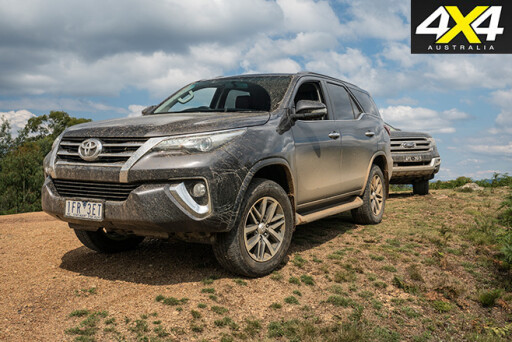 SUM UP
SUM UP
The strength of the Fortuner is that it shares much with the Hilux (powertrain included) and this bodes well for reliability and longevity. It’s well priced and well-equipped for its price, although the lack of sat-nav on the mid-spec GXL may push buyers towards the top-spec Crusade, therefore diminishing this affordability factor.
SPECS: TOYOTA FORTUNER CRUSADE
Engine: 2.8-litre 4-cyl turbodiesel
Maximum power: 130kW @ 3400rpm
Maximum torque: 450Nm @ 1600-2400rpm
Gearbox: six-speed automatic
4x4 system: dual-range part-time
Crawl ratio: 36.1:1
Tyre spec: 265/60R18 110T
Kerb weight: 2135kg
GVM: 2750kg
Payload: 615kg
Towing capacity: 2800kg
Fuel tank capacity: 80 litres
ADR fuel claim: 7.8L/100km
Test fuel use: 12.1L/100km
Touring range*: 611km
TOYOTA FORTUNER PRICES*
GX (manual): $47,990
GX (auto): $49,990
GXL (manual): $52,990
GXL (auto): $54,990
Crusade (manual): $59,990
Crusade (automatic): $61,990
*Does not include on-road costs.
THE VERDICT
These five wagons have their various strengths and weaknesses, but they are all similar in their general capabilities. All have five-star ANCAP safety and all, except the Pajero Sport, seat seven people. In auto form they can also tow between 2800kg (Fortuner) and 3100kg (Pajero Sport), although the manual Fortuner is rated to tow 3000kg.
More importantly, all of these vehicles can be driven straight from the showroom into reasonably difficult 4x4 country, without having to change anything, provided it’s not too wet, in which case the standard tyres would become a liability.
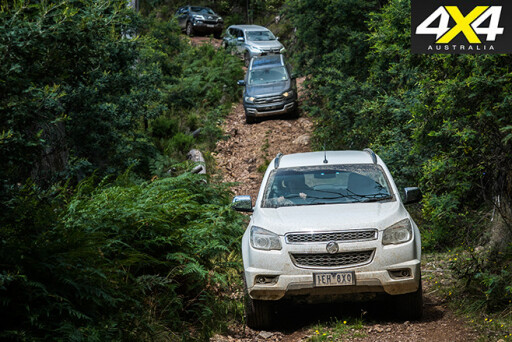 Speaking of tyres, all five wagons have off-road suitable wheel and tyre specification. 18s are standard and all will accept the 16s or 17s off their respective lower-spec models, or their ute counterpart. They all also come with full-sized spares.
Speaking of tyres, all five wagons have off-road suitable wheel and tyre specification. 18s are standard and all will accept the 16s or 17s off their respective lower-spec models, or their ute counterpart. They all also come with full-sized spares.
We asked our five test drivers to rank the vehicles from one to five on the basis of no cost difference. For all drivers the Everest ranked number one and the Fortuner ranked number two. From there opinions varied, with the Pajero Sport receiving three third places, one fourth place and one fifth place. The MU-X was close behind with two third places and three fourth places while the Colorado 7 received one fourth place and four fifth places.
All that’s very subjective, as the cost of these 4x4s varies widely, with more than $10,000 difference in the entry-level prices and more than $25,000 difference in the price of the top-spec models.

The MU-X offers solid value and should be a good ownership proposition, given its well-proven powertrain. It doesn’t have much in the way of notable equipment (bar the rear DVD in the LS-T), but it still has most things you want. The MU-X is a better proposition than its cousin, the Colorado 7, which, like the Pajero Sport, doesn’t have a CD player and only offers sat-nav via a smart phone app.
The Fortuner and the Everest stand out from the others thanks to a few things, but, most notably, because of their superior off-road ability, which puts them both in a different league.
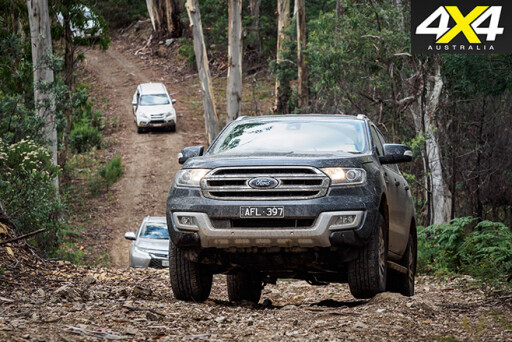 For its part, the Fortuner is cheaper than the Everest and comes with the option of a manual gearbox. It’s also a simpler vehicle than the Everest and would be the first choice for an outback tourer, given the commonality of parts with the Hilux. It’s just a pity that if you want sat-nav in your Fortuner you need to get the top-spec Crusade, which, at $59,990 for the manual or $61,990 for the auto, sees its price advantage over the Everest evaporate.
For its part, the Fortuner is cheaper than the Everest and comes with the option of a manual gearbox. It’s also a simpler vehicle than the Everest and would be the first choice for an outback tourer, given the commonality of parts with the Hilux. It’s just a pity that if you want sat-nav in your Fortuner you need to get the top-spec Crusade, which, at $59,990 for the manual or $61,990 for the auto, sees its price advantage over the Everest evaporate.
The best drive here, especially on-road, is the Everest, thanks to its ‘smart’ full-time 4x4. The Everest is at its best, in terms of value, in the mid-spec Trend ($60,990), even if you have to fork out an extra $600 for the sat-nav.

COMMENTS